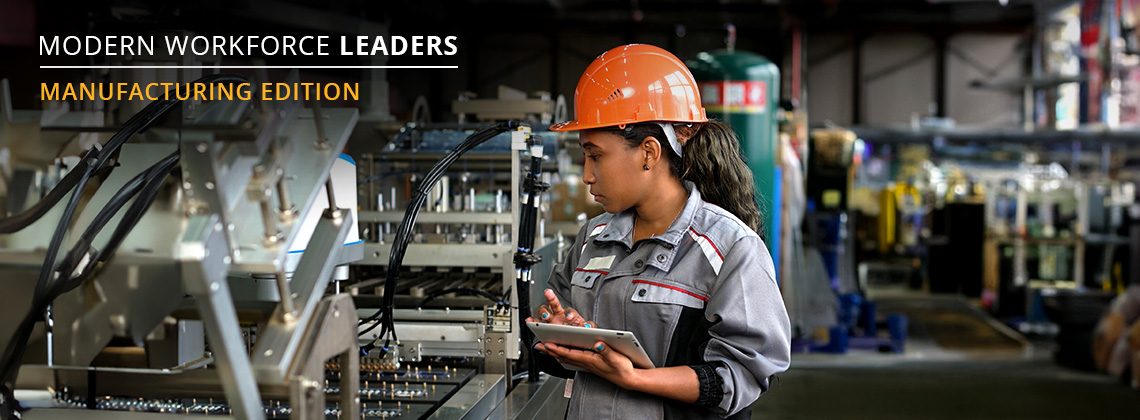Why Future Manufacturing Environments Need Workforce Flexibility and Real-Time Communication


Kurt Taratuta
Human Resources Information System Analyst at Haworth
Our Modern Workforce Leader Series—Manufacturing Edition spotlights interviews with manufacturing industry experts which are included in our The State of the Manufacturing Workforce in 2024 and Beyond report.
The following features our conversation with Kurt Taratuta, Human Resources Information System Analyst at Haworth, about increased flexibility in the workplace, the changes in employee engagement that new technologies have introduced, and the importance of having immediate communication to improve operational efficiencies and how leaders connect with workers.
WHAT INDUSTRY CHANGES HAVE OCCURRED THAT CHANGED HOW YOU ENGAGE WITH EMPLOYEES?
Since the COVID-19 pandemic, our supervisors have to manage many members in the manufacturing environment, and they have a greater need for time and attendance to be real-time.
Right now, they’re trying to make sure things are going well at the beginning of the shift, and they don’t have a good grasp on who is present. There may be situations where manufacturing lines haven’t been checked yet, and the supervisors need to know if they’re short on members and if their work is impacted.
This situation is not new, but challenging to us, and we need tools to manage this.
WHAT KEY DRIVERS WILL SHAPE HOW YOUR EMPLOYEES WORK IN THE FUTURE?
We recognize that the workforce is changing, and I think we must be more open to part-time positions, flexible schedules, and shorter pay cycles. Now, with the changes we face across the board, the newer generations want flexibility, to have higher pay and to be paid quickly.
I also think that the days of companies being able to dictate work schedules are over. We face the challenge of meeting flexible schedules and supervisors now don’t have the right tools to provide this visibility.
Those will be the challenges for us and the whole industry—flexible schedules and work/life balance and enticing workers to want to be a part of your team.
WHERE DO YOU SEE YOUR FUTURE TECHNOLOGY SPEND IN THE NEXT FEW YEARS?
We’re trying to be able to pull more real-time data to our managers in manufacturing and not only to our HR department. They can then look at it and get real-time data on our productivity, hours, and absenteeism.
I think getting that data flow and information—whether it’s REST APIs or a flat file—to leaders on time is going to lead to better planning solutions for us. Having this data and a clean look at upcoming time off or other kinds of schedules can help with forecasting and give us a better grasp on our labor planning for the week or the month.
Those are the big things that we will be looking for to take that next step: data flow, planning, and forecasting.
HOW CAN COMMUNICATION BE IMPROVED TO REDUCE OPERATIONAL EFFICIENCIES?
I’d like to look at getting “the hub” to communicate seamlessly. Managers can get those messages right away, and we can see where we have attendance issues to fix. We’re not utilizing it yet, but those are the things that I feel are the biggest challenges.
The communication I’m talking about is more of immediate communication regarding attendance and shift visibility. We do not have good visibility of that. We have supervisors in the manufacturing environment in our plants, and they might have 40 or 50 people reporting to them. But too many people are too spread out for them to know everything that’s going on.
For example, if a critical worker like a machine operator or material handler does not show up for his work assignment today, he must first get noticed by the team leader. The team leader then needs to communicate it to the supervisor, and that’s not a real quick flow.
It might take an hour or more for that manager to find out that this key person is missing, and then they’ve got to make other plans and have a backup in place. This means losing some valuable time without having that instantaneous information, and we need a better method to get that flow to the people that need to know.
WHAT ADVICE DO YOU HAVE FOR OTHER LEADERS ON WORKFORCE MANAGEMENT?
You must identify ways to keep the Gen X and the Gen Y members engaged; you can’t keep the old-school way of thinking. This means having increased levels of communication.
These generations have grown up on mobile phones, social media, and constant communication, so we’ve got to make sure that we’re seen in front of them with communication, giving them timely feedback and a feeling of belonging.
That is the biggest challenge manufacturing is facing now and, in the future—engaging those generations. If they’re not engaged and we’re not giving them the communication they need, they won’t feel like they belong and will not stay with us. The question is, how do you keep that 20-something-year-old member that’s working on a machine or an assembly line engaged? That’s the biggest thing we must address as a company and across the board.
See more interviews from industry experts and key technology trends in our report, The State of the Manufacturing Workforce in 2024 and Beyond.
Subscribe to The WorkForce Blog
Learn the art and science of maintaining productive, happy, engaged employees.
Discover More
Nucleus Insights from WorkForce Customers Research Note
Nucleus Research interviews WorkForce customers who validate why we’re ranked the #1 WFM enterprise vendor for 10 consecutive years.
Elevate Employee Experience: Checklist for Operational Leaders
Get the practical steps and technology functionalities operation leaders need to improve their employees’ work experiences.
Streamlining Complex Workforce Compliance Requirements Boosts Productivity
Discover how workforce compliance software helps EMEA organisations navigate complex legislation, enhance compliance and boost operational efficiency.



